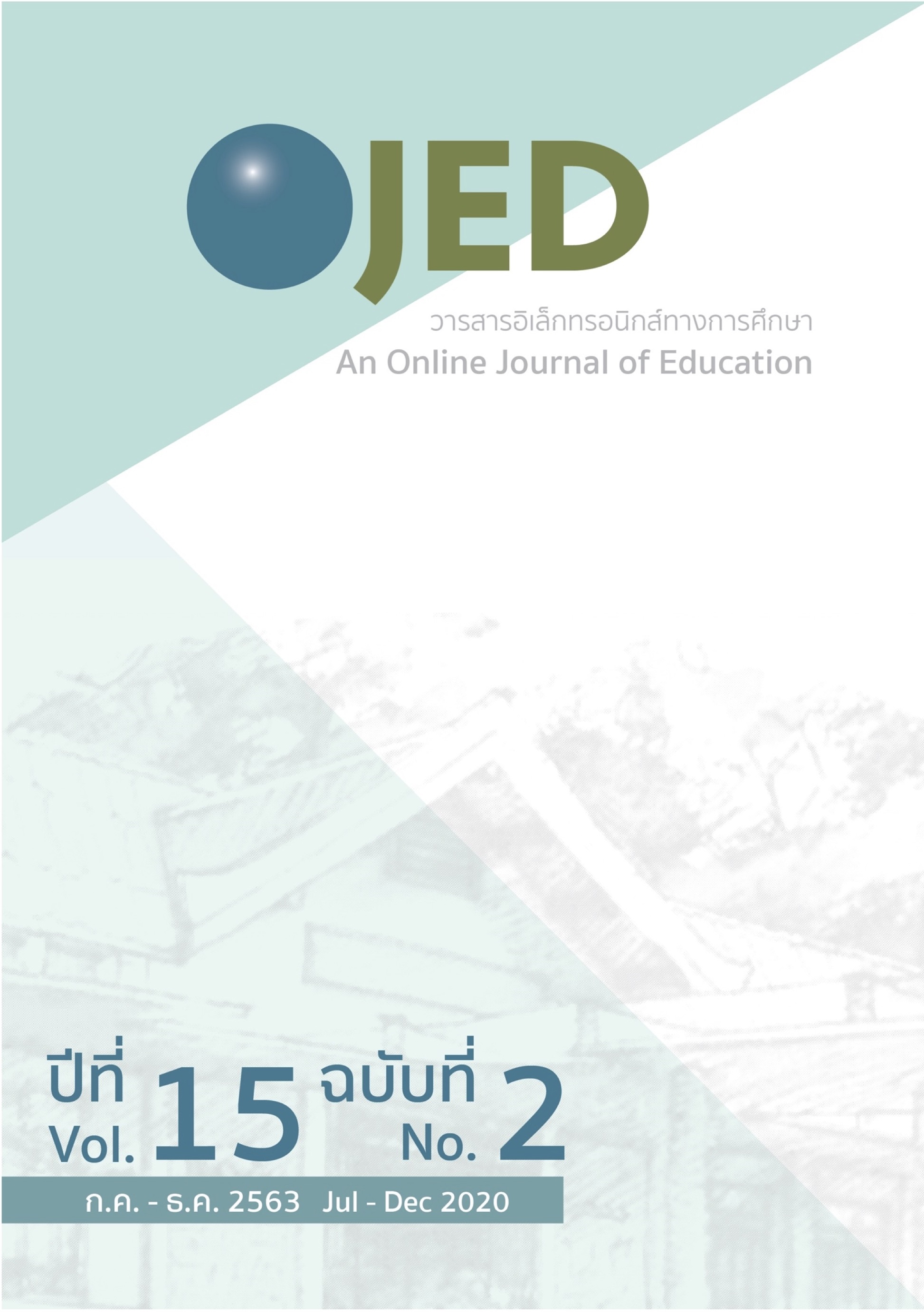The Roles of Early Childhood Teachers on Dealing with Epidemics in Schools
DOI:
https://doi.org/10.14456/ojed.2020.51Keywords:
epidemic, early childhood teachers, institutionAbstract
The epidemic is difficult to avoid and has a wide impact on social systems. Coping with the epidemic in the education system, especially at the early childhood level, it should be of great importance as the child has low immunity. They also have little experience, lack of self-protection awareness and little understanding of the dangers of abstract forms of disease. The role of kindergarten teachers in teaching and learning in educational institution management in order to prevent and control the spread of pathogens in early childhood can be achieved by adjusting the activities of teaching and learning, schedules of daily activities, and other learning activities. In addition, the teachers have to educate students on accurate practice and encourage them to act in self-care and protection, keep their bodies and different equipment clean both in the classroom and outside the classroom in accordance with the context of the educational institution and conformed to the self-defense requirements declared by the government and related to the needs of the child. Additionally, teachers should raise awareness among children in changing their lifestyle behaviors in order to protect themselves from the epidemic. An important concept for immunizing and promoting life skills in children is to cultivate it through the learning process. Kindergarten teachers need a variety of activities to help early childhood learn with fun and to cultivate knowledge, skills and positive attitudes to car for and protect themselves in preparation for the epidemic.
References
กระทรวงศึกษาธิการ สำนักงานคณะกรรมการการศึกษาขั้นพื้นฐาน. (2560). หลักสูตรการศึกษาปฐมวัยพุทธศักราช 2560. ชุมนุมสหกรณ์การเกษตรแห่งประเทศไทย.
ทิศนา แขมมณี. (2551). 14 วิธีสอนสำหรับครูมืออาชีพ (พิมพ์ครั้งที่ 8). สำนักพิมพ์แห่งจุฬาลงกรณ์มหาวิทยาลัย.
นันทิยา เมฆวรรณ และ สมเดช พินิจสุนทร. (2556). ปัจจัยที่มีผลต่อการปฏิบัติงานระบาดวิทยาของเจ้าหน้าที่สาธารณสุข ในโรงพยาบาลส่งเสริมสุขภาพตำบล จังหวัดอุดรธานี. วารสารการพัฒนาสุขภาพชุมชนมหาวิทยาลัยขอนแก่น, 1(3), 92-104.
พระราชบัญญัติโรคติดต่อ พุทธศักราช 2558. (2558, 10 สิงหาคม). ราชกิจจานุเบกษา. เล่ม 132 ตอนที่ 86 ก. หน้า 26-49.
พรเทพ สวนดอก. (2560). โนโรไวรัส (NOROVIRUS) ตัวการท้องเสียระบาดในเจ้าตัวเล็ก. โรงพยาบาลกรุงเทพ. https://www.bangkokhospital.com/th/disease-treatment/norovirus
พิไลพันธ์ พุธวัฒนะ. (2553, 9 พฤศจิกายน). รู้จัก”ไข้หวัดใหญ่สายพันธุ์ A H1N1” (ไข้หวัดเม็กซิโก). Siriraj E-Public Library. https://www.si.mahidol.ac.th/sidoctor/e-pl/articledetail.asp?id=747
ไพบูลย์ โล่ห์สุนทร. (2553). แนวคิดเกี่ยวกับสิ่งที่ทำให้เกิดโรค โฮสท์ และสิ่งแวดล้อม. ภาควิชาเวชศาสตร์ป้องกันและสังคม คณะแพทยศาสตร์ จุฬาลงกรณ์มหาวิทยาลัย.
สถาบันบำราศนราดูร กรมควบคุมโรค กระทรวงสาธารณสุข. (2556). คู่มือปฏิบัติ การป้องกันและควบคุมการติดเชื้อในโรงพยาบาล. ชุมนุมสหกรณ์การเกษตรแห่งประเทศไทย.
สำนักงานราชบัณฑิตยสภา. (2555, 30 มกราคม). โรค. สืบค้นจาก http://www.royin.go.th/?knowledges=โรค-๓๐-มกราคม-๒๕๕๕
สำนักโรคติดต่อทั่วไป กรมควบคุมโรค กระทรวงสาธารณสุข. (2558). แนวทางการป้องกันควบคุมโรคติดต่อในศูนย์เด็กเล็ก และโรงเรียนอนุบาล (สำหรับครูผู้ดูแลเด็ก) (พิมพ์ครั้งที่ 2). บอร์น ทู บี พับลิชชิ่ง.
สำนักเลขาธิการคณะรัฐมนตรี. (2559, 24 พฤษภาคม). แผนปฏิบัติการเฝ้าระวัง ป้องกัน และควบคุม โรคติดต่อหรือโรคระบาด พ.ศ. 2559-2561 ตามพระราชบัญญัติโรคติดต่อ พุทธศักราช 2558. https://cabinet.soc.go.th/soc/Program2-3.jsp?top_serl=99319520
องค์การยูนิเซฟ ประเทศไทย. (2563, 31 มีนาคม). วิธีสื่อสารกับเด็กนักเรียนเกี่ยวกับ โรคไวรัสโคโรน่า (โควิด-19). https://www.unicef.org/thailand/th/coronavirus/how-teachers-can-talk-children-about-coronavirus-disease-covid-19
อมร ลีลารัศมี. (2563, 19 กุมภาพันธ์). เรื่องน่ารู้เกี่ยวกับ COVID-19 จากโรคติดเชื้อไวรัส SARS-CoV-2. แพทยสภา. https://tmc.or.th/pdf/Covid-19-MD-AmornUpdate.pdf
เอื้อมพร สกุลแก้ว. (2550). โรคมือ เท้า ปาก. ใกล้หมอ.
Newey, S. & White, J. (2020, 22 March). Coronavirus outbreak declared a pandemic: what does it mean, and does it change anything. Telegraph UK. https://www.telegraph.co.uk/global-health/science-and-disease/pandemic-coronavirus-who-what-impact-uk/
Merriam Webster. (2020a, 27 April). epidemic. https://www.merriam-webster.com/dictionary/epidemic
Merriam Webster. (2020b, 27 April). pandemic. https://www.merriam-webster.com/dictionary/pandemic#medicalDictionary
Downloads
Published
How to Cite
Issue
Section
License
Copyright (c) 2020 An Online Journal of Education

This work is licensed under a Creative Commons Attribution-NonCommercial-NoDerivatives 4.0 International License.




